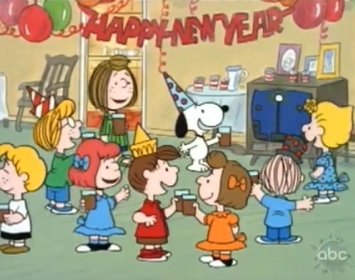On New Year’s Eve, it is almost inevitable to hear (and possibly try to sing) “Auld Lang Syne,” a song whose melody is synonymous with the new year (and the theme of change more broadly) in the English-speaking world. The text on which the song is based isn’t in English — it’s 18th-century Scots.
The story of how an 18th-century Scottish ballad became synonymous with the new year is tangled, involving both Calvinist theology’s traditional aversion to Christmas and the uniquely central role that watching television plays in American New Year’s celebrations.
As immortalized in When Harry Met Sally, a casual listener to the song is likely to be confused as to what the central opening lyric means.
The answer is that “Should old acquaintance be forgot?” is a rhetorical question. The speaker is asking whether old friends should be forgotten, as a way of stating that obviously one should not forget one’s old friends. The version of the song we sing today is based on a poem published by Robert Burns, which he attributed to “an old man’s singing,” noting that it was a traditional Scottish song. Fundamentally similar songs and poems existed in other forms in 18th-century Scotland.
What is the meaning of “Auld Lang Syne?”
Scottish people speak English with a distinctive accent, and we may also be aware of the existence of a language called Scottish Gaelic that is related to Irish and Welsh and is rarely spoken. But there is also what is known as the Scots language, which has clear similarities to English without truly being intelligible to English speakers — in much the way that Italian and Spanish are similar, but distinct, languages.
The point is that the phrase “auld lang syne” is not recognizable to English speakers because it is not an English phrase. Translated literally it means “old long since,” but the meaning is more like “old times” or “the olden days.”
When Harry Met Sally is right: It’s about old friends
As Meg Ryan’s character Sally says in the movie, this is a song about old friends. Old friends who haven’t seen each other in a while are meeting up again, having a drink, and reminiscing. If this were a song that you normally listened to in a quiet room at full length in English when sober, there would be no confusion. Since that’s basically the opposite of a New Year’s Eve party, which is when you usually hear the song, there is a lot of confusion. But the song itself is not especially complicated.
New Year’s is a big deal in Scotland
One reason a random Scottish folk song has come to be synonymous with the new year is that New Year’s celebrations (known as Hogmanay) loom unusually large in Scottish folk culture — so much so that Scotland’s official website has a whole Hogmanay section, which notes that, “Historically, Christmas was not observed as a festival and Hogmanay was the more traditional celebration in Scotland.”
Everyone likes a good party, and the end of one year and the beginning of the next seems like as good a thing to celebrate as anything else, so Scottish-inflected New Year’s celebrations — including the sentimental and appealingly nonspecific “Auld Lang Syne” — came naturally to the English-speaking world.
Canadian band leader Guy Lombardo made “Auld Lang Syne” an institution
From 1929 until 1976, first on radio and then on television, Americans tuned in to the New Year’s Eve broadcast by Guy Lombardo and the Royal Canadians, a big band act led by Lombardo, a Canadian whose parents immigrated from Italy. For decades, Lombardo owned December 31 — even earning the nickname “Mr. New Year’s Eve” — and every single year he played “Auld Lang Syne” to ring in the new year.
Then because of the influence of American movies and television shows on pop culture all around the world, conventional depictions of people ringing in the new year to “Auld Lang Syne” were beamed into living rooms globally. An 18th-century Scottish ballad thus became a midcentury American television ritual, and from there became a worldwide phenomenon — even though almost nobody understands the song.
source: www.vox.com
The lyrics of the song (Mariah Carey version):
“Auld Lang Syne (The New Year’s Anthem)”
Should auld acquaintance be forgot,
And never brought to mind?
Should auld acquaintance be forgot,
And auld lang syne!
For auld lang syne, my dear,
For auld lang syne.
We’ll take a cup o’ kindness yet,
For auld lang syne.
For auld lang syne.
Should auld acquaintance be forgot,
And never brought to mind?
Should auld acquaintance be forgot,
And auld lang syne!
For auld lang syne, my dear,
For auld lang syne.
We’ll take a cup o’ kindness yet,
For auld lang syne.
For auld lang syne, my dear,
For auld lang syne.
We’ll take a cup o’ kindness yet,
For auld lang syne.
Eh…
Happy New Year, baby
Should auld acquaintance be forgot,
And never brought to mind?
Should auld acquaintance be forgot,
And auld lang syne!
Happy New Year, baby
Happy New Year, baby
Should auld acquaintance be forgot,
And never brought to mind?
Should auld acquaintance be forgot,
And auld lang syne!
In Hungarian we usually sing the following version:
„Jut még eszedbe, kedvesem,
A boldog ifjúság,
Az erdőszéli kis patak,
S a régi jó barát.
Ó gondolj, gondolj néha rám,
A sors bármerre hajt,
Emlékül küldöm, kedvesem
A régi-régi dalt.”
Vocabulary
inevitable | elkerülhetetlen |
tangled | gubancos, bonyolult |
aversion | irtózás, idegenkedés |
to immortalize | halhatatlanná tenni |
rhetorical question | költői kérdés |
to attribute to sg | valaminek tulajdonítani |
distinctive | jellegzetes, megkülönböztethető |
intelligible | érthető, értelmes |
to reminisce | emlékezni, felidézni a múltat |
sober | józan |
to loom | kiemelkedni |
decade | évtized |
to ring in the new year | köszönteni az új évet |
depiction | leírás, ábrázolás |
anthem | himnusz |
acquaintance | ismerős, barát |





